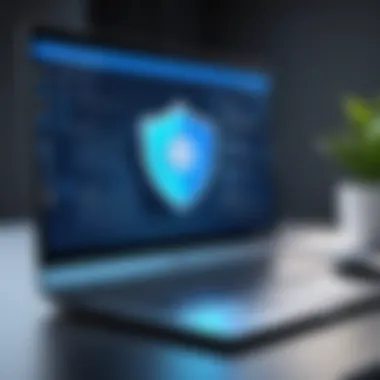Effective Strategies for TeamViewer User Management


Intro
In an era where remote collaboration is essential for business continuity, effective user management within remote access solutions like TeamViewer has become increasingly vital. The platform has gained popularity for its ability to facilitate easy and secure connections between users. This article aims to dissect the intricacies of user management in TeamViewer, elucidating various strategies and best practices that optimize this critical component.
By examining user roles, permissions, and the overall framework, we will explore how these elements contribute to enhanced security and operational efficiency. Additionally, this article will offer insightful recommendations tailored for decision-makers, IT professionals, and entrepreneurs looking to leverage TeamViewer for their organizational needs.
Understanding user management in TeamViewer is not merely about assigning roles but encompasses a broader perspective that includes safeguarding sensitive data and streamlining workflows. With this foundation, we will cover essential aspects that will equip professionals to make informed decisions and implement best practices in user management.
Next, we will provide a detailed overview of the software itself.
Preface to TeamViewer User Management
Effective user management is essential for any organization utilizing remote support and access tools. TeamViewer stands out as a premier solution in this domain. Getting familiar with TeamViewer’s user management capabilities offers several advantages. It allows teams to maintain control over user roles, adjust permissions, and ultimately enhance security protocols.
Having a solid grasp of user management means recognizing the balance between accessibility and security. Each stakeholder in an organization must have appropriate access tailored to their specific needs. This strategy reduces the potential for misuse or security breaches—critical factors in today's increasingly remote work environment. Additionally, understanding these elements aids in compliance with internal policies and external regulations.
As we delve further into this article, we will explore key features of TeamViewer, alongside best practices that ensure effective user management. These insights are valuable for IT professionals and decision-makers seeking to optimize the usage of TeamViewer within their organizations.
Understanding TeamViewer
TeamViewer is a software application for remote control, desktop sharing, online meetings, and file transfer. It enables users to access and control computers from far away, facilitating collaboration and technical support. The application is widely appreciated for its ease of use and the ability to connect seamlessly over various internet connections. It is essential for businesses that rely on remote desktop access for both internal and client-facing tasks.
In contemporary workspaces, TeamViewer provides the necessary tools for organizations to engage with clients and colleagues from various locations efficiently. The platform supports multiple operating systems, which enhances its adaptability, enabling a diverse workforce to connect regardless of their computing environment.
Importance of User Management
User management within TeamViewer is paramount for several reasons. First, it helps define user roles and responsibilities. By categorizing users as admins, regular users, or custom roles, organizations can provide tailored access that meets operational needs without compromising security. Clear delineation of roles aids in accountability, clarifying who can perform specific actions within the software.
Moreover, effective user management enhances security. Properly configured user permissions can prevent unauthorized access to sensitive data and functionalities. Organizations experience reduced risks of insider threats or accidental data leakage by limiting user capabilities.
In addition to improving security, a well-managed user system contributes to operational efficiency. Regular audits and assessments of user roles ensure that teams are not burdened with outdated permissions. This responsiveness is critical in fast-paced environments where changes in staffing or project requirements occur frequently.
User Roles in TeamViewer
User roles in TeamViewer play a fundamental part in managing access and ensuring proper functionality within the platform. Understanding these roles is essential not just for maintaining security but also for enabling effective collaboration. Users in TeamViewer are assigned specific roles, each with distinct capabilities and permissions. This structure helps organizations streamline their operations, defining who can perform specific actions while minimizing risks associated with excessive privileges.
Admin vs. Regular User
In TeamViewer, the distinction between admin and regular users cannot be understated. Admins have a higher level of access that allows them to oversee the entire user management process. This role includes creating new users, adjusting permissions, and managing settings. Admins are vital for ensuring that the software functions optimally and securely.
Regular users, on the other hand, have limited access. They can connect to remote devices and utilize TeamViewer's core features based on their assigned permissions. This role is suitable for employees who need access to specific functionalities without the risk of altering settings or user management configurations. By keeping these roles distinct, organizations can create a safer environment that reduces the risk of unauthorized changes or data breaches.
Admins must assess user needs carefully to determine the appropriate role and permissions. This evaluation helps maintain security while allowing users to function effectively.
Creating Custom Roles
Custom roles provide flexibility in how access is managed in TeamViewer. Administrators can define roles that fit the unique needs of their organization. This granularity can address specific operational requirements while ensuring compliance with security policies.


Creating a custom role involves specifying which features a user can access. For instance, an organization may need a role tailored to customer support personnel. Such a role might allow access to remote support features while restricting administrative capabilities.
Here are the key steps and considerations when creating custom roles:
- Identify User Needs: Analyze the tasks that users will perform. Select features that align with these tasks to optimize productivity.
- Define Permissions Clearly: Specify what actions the role can take. This prevents overlap that can lead to security vulnerabilities.
- Regularly Review Roles: As organizational needs change, revisiting custom roles ensures they remain relevant and compliant.
By utilizing custom roles effectively, organizations can achieve a balance between security and accessibility, ultimately leading to improved operational efficiency.
Managing User Permissions
Managing user permissions is a critical aspect of using TeamViewer effectively. Permissions define what users can do within the TeamViewer environment. Settling these permissions accurately can enhance security, streamline operations, and protect sensitive data. By understanding permissions well, organizations can minimize risks associated with unauthorized access. This section discusses the significance of user permissions and addresses its vital aspects, benefits, and necessary considerations.
Overview of Permissions
Permissions in TeamViewer are structured around controlling user actions. Users can be granted different levels of access, from basic viewing capabilities to full administrative controls. Here’s a breakdown of key types of permissions:
- View Only: Users can observe sessions without interaction.
- Remote Control: This allows access to control another user’s device.
- File Transfer: This permission lets users send and receive files.
- Admin Access: Offers full control, enabling configuration and management of users.
These categories serve to tailor and restrict access based on the user's role and the sensitivity of the tasks they handle. The overall goal here is to ensure a secure working environment and prevent any potential breaches.
Configuring User Permissions
Configuring permissions requires a meticulous approach. It begins with assessing the roles and responsibilities of users within your organization. Appropriate permissions should follow:
- Identify User Needs: Determine what each user or role needs to do.
- Set Permissions Accordingly: Based on needs, assign permissions to users to facilitate their work.
- Utilize the Management Console: Use TeamViewer's Management Console to manage and configure permissions effectively. This tool provides a centralized interface for granting and modifying user access.
- Review and Adjust Regularly: User needs can change. Regularly reviewing permissions can ensure users have only the access necessary to their work tasks.
A well-structured set of permissions enhances productivity while maintaining the necessary security levels in any organization.
Revoking Permissions
Revoking permissions is just as important as configuring them. In scenarios where a user no longer needs access, perhaps due to a role change or leaving an organization, it is crucial to remove their permissions quickly. The process involves the following steps:
- Identify Users for Revocation: Keep track of current users and their permissions regularly.
- Access the Management Console: Use TeamViewer’s Management Console to revoke permissions easily.
- Notify the User: It is best practice to communicate changes to the user in question, ensuring transparency in the process.
- Audit Access Logs: Post-revocation, audit access logs to confirm that no unauthorized access occurred after the permissions were revoked.
Revoking permissions prevents potential security breaches and preserves the integrity of sensitive information.
User Management Tools in TeamViewer
User management tools play a critical role in facilitating the effective administration of users within TeamViewer. These tools offer various functionalities that enhance oversight, streamline operations, and bolster security. Organizations can benefit significantly from these tools by optimizing how they handle user access and permissions. This section delves into two main user management tools provided by TeamViewer: the Management Console and Mobile User Management.
The Management Console
The Management Console serves as a central hub for overseeing user activities and configurations in TeamViewer. This web-based interface allows administrators to manage users, assign roles, and monitor access. One of its notable features is the ability to view all users in real-time, providing immediate insight into their online status and recent activities.
Benefits of the Management Console:
- User Overview: Administrators can easily access a list of current users, including their roles and permissions.
- Role Assignment: The console simplifies assigning custom roles based on the needs of the organization.
- Audit Trails: It keeps a detailed log of user actions, which is crucial for accountability and compliance.


Implementing the Management Console can lead to more efficient workflows. For example, an IT manager can quickly identify which team members require access to specific files or applications, streamlining the onboarding or offboarding process.
"The Management Console is essential for ensuring that user management aligns with security protocols within an organization."
Mobile User Management
Mobile User Management extends the capabilities of user management to mobile devices, enabling administrators to oversee user settings on the go. As remote work becomes increasingly common, having access to user management tools via mobile applications becomes vital for maintaining organizational security.
Key Features of Mobile User Management:
- Remote Access: Admins can manage user permissions and roles from anywhere, ensuring continuous oversight.
- Alerts and Notifications: The tool provides real-time alerts for any unauthorized access attempts or changes in user status.
- User Activity Monitoring: Administrators can track user activity and usage metrics directly from their mobile devices.
Incorporating Mobile User Management enhances an organization’s agility. It ensures that IT professionals can respond promptly to issues or make necessary adjustments, thus reducing potential security risks before they escalate. This capability is particularly beneficial for decision-makers who need immediate access to critical data while traveling or working off-site.
In summary, both the Management Console and Mobile User Management offer essential features that streamline user management in TeamViewer. These tools not only simplify user configuration but also significantly strengthen security and operational efficiency. As organizations continue to adapt to a digital workforce, leveraging these management tools becomes paramount.
Best Practices for Effective User Management
Effective user management is crucial for optimizing the use of TeamViewer in any organization. This entails not only the assignment of roles but also ensuring that users have the right access levels and that security measures are in place. By establishing clear practices, you promote an environment of accountability and efficiency. Key aspects include setting solid policies and performing regular audits of user data. These practices contribute to reducing risks and enhancing the overall effectiveness of remote collaboration.
Establishing Clear Policies
Creating clear policies around user management is not just beneficial; it’s essential. Policies provide a framework that guides how users should interact with the TeamViewer platform. This can cover areas such as:
- User onboarding procedures
- Definition of different user roles
- Password management policies
- Data handling protocols
When users understand the expectations set by these policies, they are likely to adhere to them. Clear guidelines also assist administrators in enforcing rules consistently. This reduces the potential for misuse of the system and the data it handles. Organizations should regularly review and update these policies as their needs evolve.
A transparent policy framework fosters trust within teams and cultivates a culture of responsibility.
Regular Audits of User Access
Conducting regular audits of user access is an important practice for maintaining security. These audits help in identifying and addressing any potential weaknesses in the user management system. Key focuses during audits include:
- Reviewing user roles and permissions
- Checking for inactive accounts
- Ensuring that only authorized personnel have access to sensitive information
By routinely examining who has access to what, organizations can quickly detect unauthorized changes or anomalies. This practice significantly enhances your security approach. It also illustrates a proactive stance in user management. Use tools available within TeamViewer, such as the Management Console, to facilitate this process. Regular audits not only protect organizational data but also ensure compliance with any relevant regulations, promoting accountability among users.
Enhancing Security through User Management
User management is a critical aspect of maintaining security within TeamViewer. With the increasing reliance on remote access tools, organizations must prioritize security to protect sensitive data and ensure that only authorized individuals have access to their systems. Proper user management strategies can significantly reduce the risk of unauthorized access and data breaches.
Effective user management involves various practices that address security concerns. This includes defining user roles, setting permissions, and employing additional security measures such as two-factor authentication. By implementing a well-structured user management system, companies can enhance operational efficiency while safeguarding their assets.
Two-Factor Authentication
Two-factor authentication (2FA) is a powerful security measure that requires users to provide two forms of identification before accessing their accounts. This additional layer of security drastically reduces the likelihood of unauthorized access by ensuring that even if a password is compromised, the account remains protected.


To implement 2FA in TeamViewer, administrators must first enable this feature in the security settings. Users will then be prompted to register a secondary verification method, such as a mobile device or an authentication app. Following this setup, whenever a user attempts to log in, they will be required to enter a one-time code sent to their registered device.
The benefits of two-factor authentication include:
- Increased Security: It adds an extra barrier against unauthorized access.
- User Confidence: Employees feel more secure knowing their accounts are protected.
- Regulatory Compliance: Some industries require two-factor authentication to comply with data protection laws.
Monitoring User Activity
Monitoring user activity is another essential aspect of enhancing security through user management. By tracking user actions within the TeamViewer platform, organizations can identify unusual behavior that may indicate a security threat.
This monitoring can include:
- Tracking Login Attempts: Recording successful and failed login attempts helps identify potential unauthorized access.
- User Sessions: Observing active sessions can alert administrators to any suspicious access patterns.
- Audit Trails: Maintaining detailed logs of user activities provides accountability and may be necessary for compliance.
Regular monitoring can help resolve security issues before they escalate into significant problems. It allows for real-time insights into user behavior, helping organizations make informed decisions regarding user access and permissions.
"Understanding user management and its security implications is crucial for maintaining the integrity of remote access systems."
Common Challenges in User Management
Effective user management within TeamViewer is not without its obstacles. Organizations often face several challenges that can hinder their ability to optimize user interactions and ensure security. Recognizing these challenges is crucial for IT professionals and decision-makers looking to enhance their remote collaboration frameworks. Addressing these issues can lead to better productivity, security, and user satisfaction.
Handling User Requests
One significant challenge lies in managing user requests effectively. Users often require access modifications, new permissions, or assistance with technical issues. Responding to these requests in a timely manner is vital but can create backlogs when multiple requests arise simultaneously.
- Prioritization of Requests: IT teams must assess the urgency and importance of each request. High-priority requests from executives or mission-critical applications should take precedence over routine access changes.
- Clear Communication Channels: Establishing effective channels for users to submit requests can streamline the process. For instance, integrating a ticketing system can help track requests systematically.
- Documentation: Providing thorough documentation on how to submit requests can reduce the number of redundant inquiries and free up time for IT personnel.
By implementing these strategies, organizations can handle user requests more proficiently, leading to enhanced operational efficiency.
Addressing User Accountability
Accountability is another vital area of concern within user management. Organizations need to ensure that users are responsible for their actions on the platform. Lack of accountability can lead to security breaches and misuse of sensitive information.
- Establishing Policies: Organizations must clearly define user responsibilities. This involves creating comprehensive usage policies that outline acceptable behavior and the consequences of violations.
- Regular Audits: Conducting regular audits of user activity is essential for monitoring adherence to policies. These audits should assess access levels, changes made by users, and overall compliance with security standards.
- Incentivizing Good Practices: Encouraging and rewarding responsible behavior can enhance user accountability. Recognition programs for teams or individuals who demonstrate exemplary adherence to security and operational policies can motivate others.
The way users behave on platforms directly affects both security and productivity. Establishing clear expectations and accountability mechanisms is non-negotiable for any organization utilizing TeamViewer.
In summary, addressing common challenges in user management requires a proactive approach. IT teams must focus on effectively managing user requests while establishing accountability. By navigating these challenges, organizations can foster an environment that enhances both security and efficiency in remote collaborations.
Epilogue
In today's digital landscape, the importance of effective user management within remote tools like TeamViewer cannot be overstated. This article emphasizes how critical it is to not only understand the functionality of user roles and permissions but also to implement robust strategies. The blend of user management practices increases the security posture and streamlines operational efficiency.
The Future of User Management in Remote Access Tools
As organizations increasingly rely on remote access solutions, the future of user management in these tools will hinge on enhanced capabilities. Technologies such as AI will potentially streamline the verification of user identities. Predictive analytics could play role in anticipating and mitigating threats before they surface.
Organizations may lean towards solutions that offer seamless integration with existing security infrastructures. This allows for more synchronized policy enforcement across platforms. Privacy concerns will also drive the call for more refined user permissions. A shift towards more transparent user activity monitoring will likely occur, ensuring compliance and accountability.
Final Thoughts and Recommendations
To summit the ever-evolving challenges in user management, organizations should embrace an adaptive approach. Regular policy reviews and user training strengthen compliance and awareness. As remote work becomes more entrenched, prioritizing user management strategies will help in safeguarding sensitive information while improving functionality.
In summary, decision-makers and IT professionals must focus on implementing best practices within TeamViewer user management. Such steps not only enhance security but also facilitate smoother remote collaboration. Adequate strategies are essential to tackle the increasing complexity of user management in a digitally interconnected workplace.







